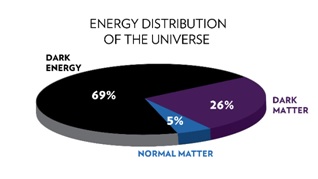

Context
Recently World's most sensitive dark matter detector, a Dark matter detector experiment named LUX-ZEPLIN (LZ) in South Dakota (U.S) delivered its first results. The machine could help unlock one of the biggest mysteries in physics ‘the nature of dark matter?by directly detecting its constituent particles for the first time.
Background
- The Universe is driven by four fundamental forces: gravity, electromagnetism, and strong and weak nuclear forces.
- So, when matter behaves in a way that is odd or unexplainable using the given fundamental forces, one idea that often gets considered is that there might be another force at work.
- Perhaps there is a fifth fundamental force we haven't yet discovered, for example, the mystery of dark matter.
About
About LUX-ZEPLIN (LZ):
- LUX-ZEPLIN (LZ) is a next-generation dark matter experiment, selected by the US Department of Energy (DOE) as one of the three ‘G2’ (for Generation 2) dark matter experiments.
- Axion Dark Matter eXperiment Gen 2
- LUX-ZEPLIN (LZ)
- Super Cryogenic Dark Matter Search at SNOLAB
- LUX-ZEPLIN, the world’s most sensitive weakly interacting massive particles (WIMP) dark matter detector, is actively taking data at deep below the Black Hills of South Dakota in the Sanford Underground Research Facility (SURF).
- It is the most sensitive dark matter detector in the world. To give an idea of the degree of difficulty in measuring evidence of a dark particle, it is said that the chamber of this LZ detector, can contain only one gram of dust if it is to detect a dark matter particle.
|
What are WIMPs?
|
What is Dark Matter?
- Dark matter: It is a hypothetical form of matter thought to account for approximately 85% of the matter in the universe. It forms the skeleton on which galaxies form, evolve, and merge.
- Dark matter is made up of particles that do not have a charge. So, these particles are “dark”, namely because they do not emit light, which is an electromagnetic phenomenon, and “matter” because they possess mass like normal matter and interact through gravity.
- Evidence for dark matter: Itcomes from calculations showing that many galaxies would fly apart, that they would not have formed, or that they would not move as they do if they did not contain a large amount of unseen matter.

Why is Dark Matter so elusive?
- It is not easy to detect dark matter any other way besides gravitationally. Also, the Gravitational force, besides not being fully integrated and understood by particle physicists, is extremely weak.
- Unfortunately, all Earth-bound lab ways of seeing and measuring particles involve having them interact either electromagnetically or via nuclear force. A particle that interacts so weakly becomes rather elusive to detect.
Why do physicists believe strongly that dark matter exists?
- If we look at stars all the way from the Centre of any galaxy to its rim, the way the velocities of the observed stars change may be plotted.
- While plotting if we assume that only the visible matter exists and nothing else then there is a marked difference between the observed plot of star speeds and the calculated value as you move from the inner part of the galaxy towards its rim.
- Now if you assume there is a certain fraction of matter which exerts a gravitational pull on the rest of the stars in the galaxy, for it cannot be seen in any other way and recalculate the plot, it fits in with the observed value. This means that there is a definite amount of dark matter in the galaxy.
Potential candidates to be qualified as Dark Matter particles:
- The WIMP: The weakly interacting massive particle, or 'WIMP', is a hypothetical particle that looks promising. It would be completely different from the type of matter we know and would interact via the electromagnetic force, which would explain why they are largely invisible in space.
- The axion: Axions are low-mass, slow-moving particles that don't have a charge and only interact weakly with other matter which makes them difficult – but not impossible – to detect. Only axions of a specific mass would be able to explain the invisible nature of dark matter – if they are any lighter or heavier, we would be able to see them.
- The MACHO: MACHO stands for 'massive astrophysical compact halo object' and was one of the first proposed candidates for dark matter. These objects, including neutron stars, and brown and white dwarfs, are composed of ordinary matter.
- The Kaluza-Klein particle:The Kaluza-Klein theory is built around the existence of an invisible 'fifth dimension' curled up in space, in addition to the three spatial dimensions we know (height, width, depth), and time. This kind of particle could interact both via electromagnetism and gravity. However, as it is curled up in a dimension we can't see, we wouldn't observe it by just by looking at the sky
- The gravitino: Theories combining general relativity and 'supersymmetry' predict the existence of a particle called the gravitino. The gravitino would be the superpartner of the hypothetical 'graviton', thought to mediate the force of gravitation. And in some models of supergravity where the gravitino is very light, it could account for dark matter.
- Other candidates for dark matter are hypothetical particles such as sterile neutrinos, supersymmetric particles, geons, or primordial black holes.
|
The neutrino could have been an excellent candidate if it had been more massive. However, being too light, it doesn’t fit. |
Conclusion
It is essentially impossible to understand our observation of history, of the evolutionary cosmos without dark matter. So, while there’s little doubt that dark matter exists, there’s lots of doubt about what it is. The leading theory is that it involves things called WIMPs- weakly interacting massive particles. If that’s the case, LUX-ZEPLIN could be able to detect them.The search is on to find one of these candidates.


